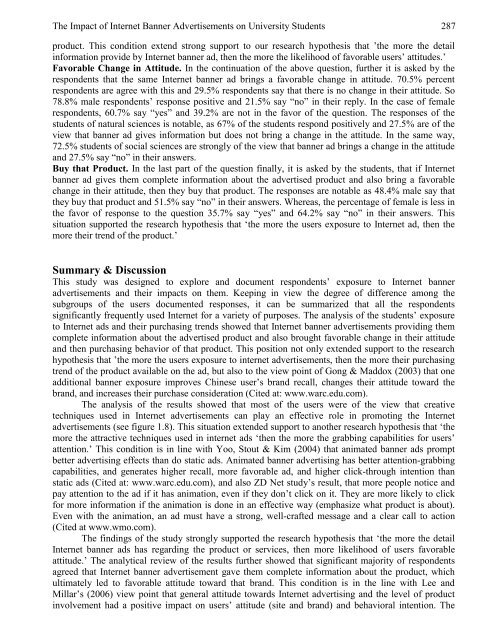European Journal of Scientific Research - EuroJournals
European Journal of Scientific Research - EuroJournals
European Journal of Scientific Research - EuroJournals
Create successful ePaper yourself
Turn your PDF publications into a flip-book with our unique Google optimized e-Paper software.
The Impact <strong>of</strong> Internet Banner Advertisements on University Students 287<br />
product. This condition extend strong support to our research hypothesis that ’the more the detail<br />
information provide by Internet banner ad, then the more the likelihood <strong>of</strong> favorable users’ attitudes.’<br />
Favorable Change in Attitude. In the continuation <strong>of</strong> the above question, further it is asked by the<br />
respondents that the same Internet banner ad brings a favorable change in attitude. 70.5% percent<br />
respondents are agree with this and 29.5% respondents say that there is no change in their attitude. So<br />
78.8% male respondents’ response positive and 21.5% say “no” in their reply. In the case <strong>of</strong> female<br />
respondents, 60.7% say “yes” and 39.2% are not in the favor <strong>of</strong> the question. The responses <strong>of</strong> the<br />
students <strong>of</strong> natural sciences is notable, as 67% <strong>of</strong> the students respond positively and 27.5% are <strong>of</strong> the<br />
view that banner ad gives information but does not bring a change in the attitude. In the same way,<br />
72.5% students <strong>of</strong> social sciences are strongly <strong>of</strong> the view that banner ad brings a change in the attitude<br />
and 27.5% say “no” in their answers.<br />
Buy that Product. In the last part <strong>of</strong> the question finally, it is asked by the students, that if Internet<br />
banner ad gives them complete information about the advertised product and also bring a favorable<br />
change in their attitude, then they buy that product. The responses are notable as 48.4% male say that<br />
they buy that product and 51.5% say “no” in their answers. Whereas, the percentage <strong>of</strong> female is less in<br />
the favor <strong>of</strong> response to the question 35.7% say “yes” and 64.2% say “no” in their answers. This<br />
situation supported the research hypothesis that ‘the more the users exposure to Internet ad, then the<br />
more their trend <strong>of</strong> the product.’<br />
Summary & Discussion<br />
This study was designed to explore and document respondents’ exposure to Internet banner<br />
advertisements and their impacts on them. Keeping in view the degree <strong>of</strong> difference among the<br />
subgroups <strong>of</strong> the users documented responses, it can be summarized that all the respondents<br />
significantly frequently used Internet for a variety <strong>of</strong> purposes. The analysis <strong>of</strong> the students’ exposure<br />
to Internet ads and their purchasing trends showed that Internet banner advertisements providing them<br />
complete information about the advertised product and also brought favorable change in their attitude<br />
and then purchasing behavior <strong>of</strong> that product. This position not only extended support to the research<br />
hypothesis that ’the more the users exposure to internet advertisements, then the more their purchasing<br />
trend <strong>of</strong> the product available on the ad, but also to the view point <strong>of</strong> Gong & Maddox (2003) that one<br />
additional banner exposure improves Chinese user’s brand recall, changes their attitude toward the<br />
brand, and increases their purchase consideration (Cited at: www.warc.edu.com).<br />
The analysis <strong>of</strong> the results showed that most <strong>of</strong> the users were <strong>of</strong> the view that creative<br />
techniques used in Internet advertisements can play an effective role in promoting the Internet<br />
advertisements (see figure 1.8). This situation extended support to another research hypothesis that ‘the<br />
more the attractive techniques used in internet ads ‘then the more the grabbing capabilities for users’<br />
attention.’ This condition is in line with Yoo, Stout & Kim (2004) that animated banner ads prompt<br />
better advertising effects than do static ads. Animated banner advertising has better attention-grabbing<br />
capabilities, and generates higher recall, more favorable ad, and higher click-through intention than<br />
static ads (Cited at: www.warc.edu.com), and also ZD Net study’s result, that more people notice and<br />
pay attention to the ad if it has animation, even if they don’t click on it. They are more likely to click<br />
for more information if the animation is done in an effective way (emphasize what product is about).<br />
Even with the animation, an ad must have a strong, well-crafted message and a clear call to action<br />
(Cited at www.wmo.com).<br />
The findings <strong>of</strong> the study strongly supported the research hypothesis that ‘the more the detail<br />
Internet banner ads has regarding the product or services, then more likelihood <strong>of</strong> users favorable<br />
attitude.’ The analytical review <strong>of</strong> the results further showed that significant majority <strong>of</strong> respondents<br />
agreed that Internet banner advertisement gave them complete information about the product, which<br />
ultimately led to favorable attitude toward that brand. This condition is in the line with Lee and<br />
Millar’s (2006) view point that general attitude towards Internet advertising and the level <strong>of</strong> product<br />
involvement had a positive impact on users’ attitude (site and brand) and behavioral intention. The

















